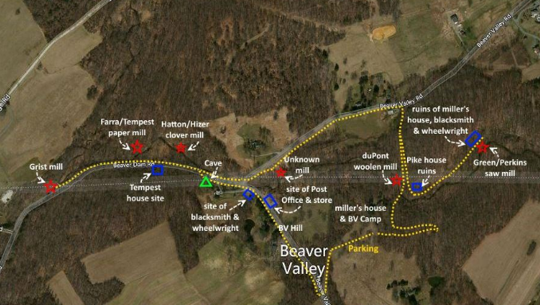When:
April 15, 2017 @ 10:00 AM – 1:00 PM
2017-04-15T10:00:00-04:00
2017-04-15T13:00:00-04:00
Learn about the mills, houses, businesses, and former residents of Beaver Valley on this guided tour back through time. Scout out old remnants that tell a rich history of the past. Discover places you may have seen before but would never have know have a story to tell.
LOCATION:
Use this google maps (see link below), because Bing maps is showing the wrong location.
https://goo.gl/maps/J569zwSVxS12
BRING:
Please print out your trail guides and bring them to the event. Downloadable here:
https://drive.google.com/open?id=0B3gNpRqyjW3KdmRMWWVWVTRwR2s
About Save The Valley
We are a group of concerned citizens who aim to prevent the development of land owned by the Woodlawn Trustees, and aim to preserve it for public recreational use.
701 Beaver Valley Rd, Wilmington, DE 19803-1108

History Hike
Miller’s house, and Beaver Valley Camp, operated by Associated Charities –leased from Woodlawn Company and William Bancroft to provide freshair and nature to inner city children. Camp was here from 1916 purchase by Woodlawn until 1920 when it moved to the Hockessin area, and became known as Camp Wright. Miller’s house dates to 1752.
Beaver Valley Hill–the toughest hill in the area, and where all the car manufacturers came to test their vehicles.
The hamlet of Beaver Valley, informally known as “Chandler’s Hollow” for the many Chandlers who lived in the area and founded the village. Site of a blacksmith shop and wheelwright shop, Post Office (1865–1900), butcher shops, general store. Also the center of social life in the 1800’s and early 1900’s.
The Cave of Delaware: archaeological investigations in the 1940’s confirmed that the cave (really a rock shelter) was used by Native Americans for centuries. Local lore has it that soldiers fleeing the British during the Battle of the Brandywine hid here. Also used in the filming of the movie “Dead Poets Society” with Robin Williams.
Clover mill owned by Gideon Hizer and Peter Hatton. A clover mill separates the seed from the plant, for the next year’s crop of clover. Was later used to manufacture Turkish carpets.
Paper mill of Francis Tempest. Originally built as a woolen mill by John Farra in 1810, but was rebuilt as a paper mill after the original structure was destroyed in a fire. Also known as Sunnydale Paper Mill, and Beaver Valley Paper Mill. Was the last mill to operate in the Valley, and is rumored to have been used as a still during Prohibition.
Site of Francis Tempest’s house, built in the late 1800’s, and destroyed by fire in 1947.
Grist mill–first known mill at this site dates to 1712, and was operated by Joseph Robinson. Later known as Gibson’s Mill, Beaver Valley Mills. Wasin operation until around 1900.
Unknown mill and mill races, owned and operated by Peter Hatton. Green/ Perkins sawmill : originally owned by Robert Green Jr.; was known to be in operation by 1772. Likely supplied the lumber for many of the area’s houses and barns. Was in use until about 1900.
Miller’s house: probably built between 1772 and 1800. Ruins of blacksmith and wheelwright shop just northeast of the miller’s house.
Pike house ruins: an old log house existed at this site until the last occupant left in the 1950’s.
Charles duPont woolen mill, operated by Louis Sacriste and then his son, Charles Sacriste from 1825–1843, when it was completely washed out in the infamous “Flood of 1843”

Comments